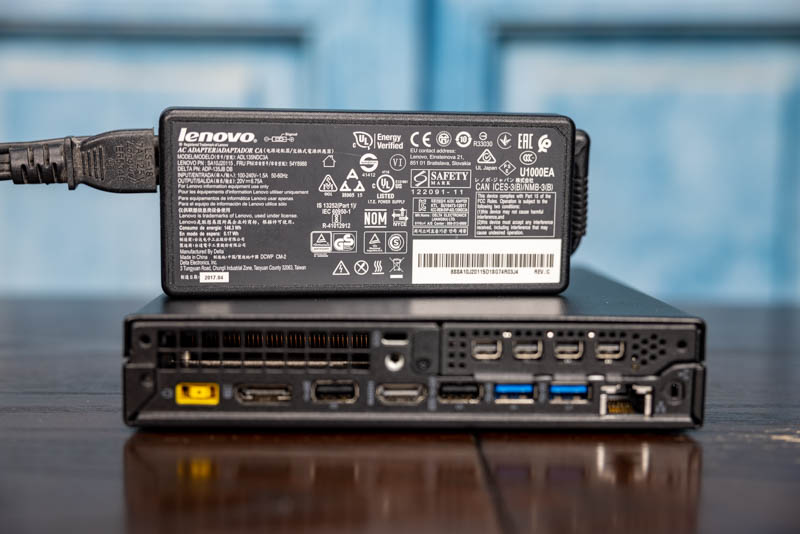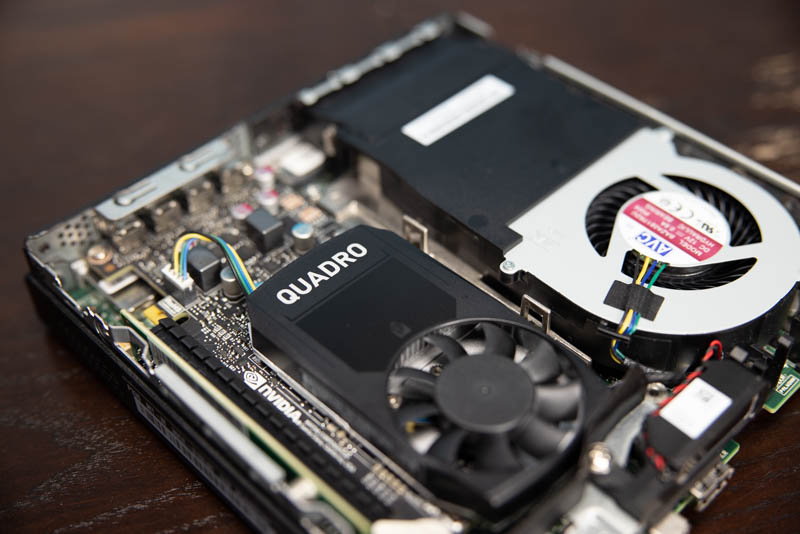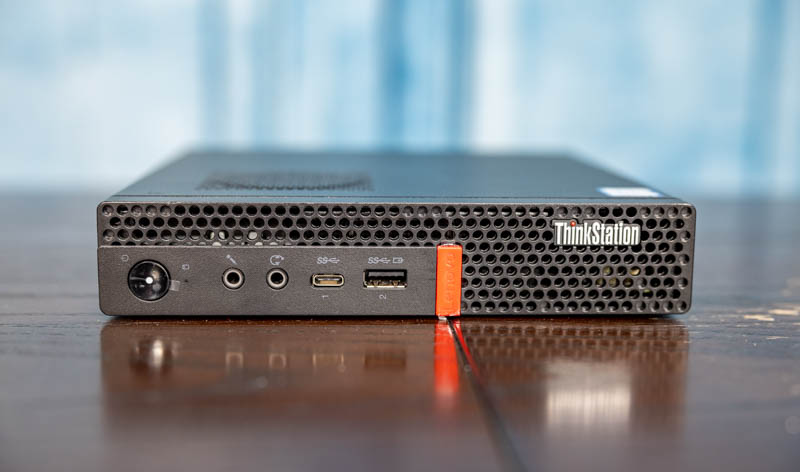Power Consumption
Idle power consumption on 120V power we saw 30-35W idle for the six-core unit. We generally assume these nodes will use 9-12W idle so this was a bit higher but makes sense given the GPU. Again, these are used units so it may vary a bit.
The power supply for this unit is a 135W Lenovo power adapter from the company’s notebook line. This is bigger than a typical 65W power adapter we saw with previous generations and also bigger than the 90W units we saw in our Lenovo ThinkCentre M920 and M920q Tiny Guide and Review but similar to what we saw with the ThinkStation P320 and ThinkCentre M920x, both with GPUs. This power is needed to drive the GPU and additional cooling. We did get our test unit to pull over 105W.

At idle, the noise is still relatively quiet. Under heavier loads, the fan spins up and the system is very audible. This is a function of having a CPU and GPU in a small package like this. There is little room to add elaborate cooling and larger quieter fans.
Next, we are going to discuss key lessons learned before getting to our final thoughts.
Key Lesson Learned for TMM
In this series, we wanted to also focus on some key lessons learned. Since we have already tested well over a dozen different models, we are taking away key pieces of advice from each that we wanted to share.
Our key lesson learned for this one comes down to two facts. First, we ended up getting a Quadro GPU and a faster Core i7 CPU for around $200 more than we would have expected for a lower-end unit. In many cases, where one needs many inexpensive nodes, this would be an unwise upgrade. For the extra performance and capabilities, many of our readers may find it worthwhile to look at this versus a lower-end ThinkCentre machine.

In terms of capabilities, the additional display outputs ended up coming in handy. Instead of using this node as a cluster node, as we originally intended, we ended up using it to drive multiple display outputs in the STH YouTube studio. Perhaps that serves as a good lesson. We purchased a higher-end and more expensive unit, but that led to a new use case outside of what we intended.
Final Words
We already reviewed the Lenovo ThinkStation P320 Tiny and had a piece on the Lenovo ThinkCentre M920x. Both of those units had GPUs as well. While the CPU was newer in the P330 Tiny, we would certainly look at the other two units as competitors and make a decision on pricing. A deal on the other two may make the P330 Tiny seem expensive, but the inverse is true as well.

Our Lenovo P330 Tiny carried a bigger premium when we compare the cost of the components to the cost of the system. Still, spending under $175 or so for the chassis, motherboard, Windows 10 Pro license, and power supply over the sum of the used costs of the CPU, GPU, RAM, and SSD seems reasonable. Our readers are going to have to weigh that for themselves.
Clearly, with the Core i7-8700T and the NVIDIA Quadro P620, along with the ability to support 64GB of memory and two M.2 NVMe SSDs, the Lenovo ThinkStation P330 Tiny is an excellent unit for those looking for a small system that can also provide a lot of expansion. At the same time, larger systems offer even more expandability so there is a balance here.
Earlier this week, we reviewed a massive server with 160 cores. You can see that in our Ampere Altra Wiwynn Mt. Jade Server Review. Although the Apple Mac Mini M1 is a step in the right direction, this Lenovo ThinkStation P330 Tiny is exactly the type of machine that Arm needs to bridge the gap between the Raspberry Pi and higher-end servers. The deployment flexibility (there are even dust filter options) plus all of the configuration capabilities make this a flexible little machine.
Overall, this is a great unit, albeit not perfect. For a segment of the TinyMiniMicro market, we think this is going to be a top choice while others will want to avoid. Perhaps that is the point of a system like the Lenovo ThinkStation P330 Tiny insofar as it caters to the upper end of the 1L system market.




Thanks for the review.
I was very interested into buying one of these as a Plex server given the capability of the entry level Quadro for the 2-3 family members on my server, but as it would sit in my living room, it sounds like the noise would be an issue…
Any recommendation for a similarly spec’ed system, but quiet? (doesn’t necessarily have to be that small)
Maybe better to assemble one myself?
STH wrotte: “ M.2 retention mechanism is a blue tool-less design as we saw in the M920x Tiny. After servicing a few dozen of these nodes, having everything tool-less is a major design win for us. ”
I have bad experience with these m.2 tool-less blue nightmarish mechanism on several P320 proxmox nodes…after three years in use, there was need to remove nvme and these blue knobs was so tight, that imposible remove them with bare hands and i have nails on long side..so i everytime there is need to use tools to do that.
Thanks for the review and video, really informative. If one was willing to sacrifice the GPU, could the PCI slot be used for a 10-gig Ethernet adapter?
Good review of the system. Any chance providing a pointer to a website where these are sold for the mentioned price?
Amazing! Had been looking at buying some NUC 9s to set up a lab, but one of these popped up on Ebay with the i7-8700t CPU relatively cheap (at least for the UK) and just popped in a Dual 10 Gb card and VMware seems very happy with it all! Am now keeping an eye out for any bargains and should have a 3 host lab with 10Gb connectivity for less than the cost of one loaded NUC9!
2 fringe downers vs the NUC are no support for 110mm drives and no 2nd slot for something like an Nvidia T4 or similar – That said, if I had the money for T4s and licensing lying around I’d also have bought the NUC 9 or something like one of the embedded Xeon Supermicro boxes.
STH wins again :D
I have had one of these for four and a half years now. I have periodically upgraded it as parts got cheaper. It started as an i7-8700T with 16GB of RAM, 250GB M.2 drive and a P630 2GB video card. It now has an i9-9900T with 32GB of RAM, both the 250GB and a 1TB M.2 disk as well as a T1000 8GB video card. I picked up the DVD cage as well as the special cable for a song and then removed and upgraded the drive to one capable of UHD Bluray. Capable of easily playing a UHD Bluray disk and being quiet while doing it makes this the perfect portable theater rig. Paired with an LG PF1500 LED projector, an FXAudio 802C Pro amp, and a pair of Zilch modded RS Optimus Pro 7 speakers I consider this the ultimate setup. For desktop use I can’t see where you could go wrong again. It boots in about 10 seconds, is stunningly fast and very compact, has ports galore, and is capable of running multiple monitors. Of course there is the down side and that is the WiFi card and interface. It is CNVio, the winmodem of WiFi, and essentially removes any option for upgrading the WiFi. I can’t say what I think of this interface for fear of having the post cut. Other than that, pick up one for a song and do a bit of upgrading and you have a decade computer.